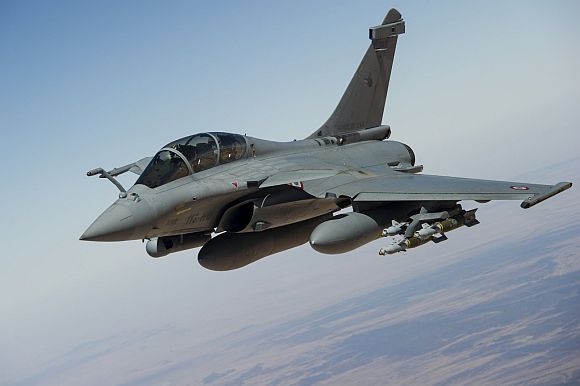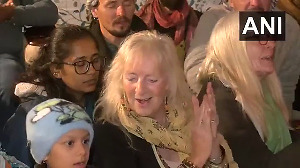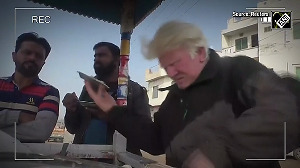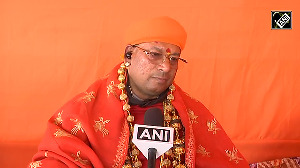Is the price of one fighter Rs 681 crore? Rs 686 crore? Rs 703 crore? Rs 1,063 crore? Rs 1,225 crore?
Ajai Shukla makes sense of the confusing numbers.

Has the Indian Air Force paid more per Rafale fighter than what Prime Minister Narendra D Modi had undertaken in Paris whilst announcing his agreement with then French president Francois Hollande to buy 36 aircraft from the French vendor, Dassault?
On April 10, 2015, standing beside Hollande, Modi declared: 'Keeping in mind the critical operational necessity of fighter aircraft in India, I have discussed with the president the purchase of 36 Rafale fighters in 'fly-away condition' at the earliest through an inter-governmental agreement.'
'We have both agreed that these would be supplied on better terms and conditions than were offered to India in a separate procurement process.'
The 'separate procurement process' Modi referred to was an ongoing tender the IAF issued in 2007 for 126 medium multi-role combat aircraft.
In response to that tender, Rafale had submitted a commercial bid in 2008-2009, quoting a price for 18 Rafale fighters 'in fly-away condition', and 108 fighters to be built in India.
Now the Congress party alleges that the Modi government, in buying 36 Rafales for €7.8 billion ($9.2 billion or Rs 58,000 crore/Rs 50 billion), paid more than what Dassault had quoted in the MMRCA tender.
If that is the case, the PM's public commitment was violated.
In the absence of government figures, analysts must extrapolate from other available, if less authoritative, sources.
Defence Minister Nirmala Sitharaman committed at a press conference that the Rafale bid figures would be publicly released. Despite my subsequent requests, no figures have been forthcoming.
A full breakdown of figures is essential because the total cost of a fighter contract includes -- besides the cost of the aircraft -- costs related to technology transfer, spare parts, weapons and missiles, added-on equipment and maintenance costs.
A valid comparison, on an apples-to-apples basis, requires 'non-aircraft' costs to be isolated from the price being paid for the aircraft.
Cost of the current deal
Fortunately, authentic figures are available for the €7.8 billion contract, signed in 2015, for 36 Rafales.
Soon after the contract was signed, a senior political leader in the National Democratic Alliance held an off-the-record briefing in New Delhi for several journalists, including this correspondent.
It was divulged that the contracted price averaged out to €91.7 million (Rs 686 crore/Rs 6.86 billion) per Rafale.
This included the purchase of 28 single-seat fighters, for €91.07 million (Rs 681 crore/Rs 6.81 billion) each; and eight twin-seat fighters, each priced at €94 million (Rs 703 crore/Rs 7.03 billion).
That puts the cost of each of the 36 'bare bones' fighters at €91.7 million (Rs 686 crore) -- totalling up to €3.3 billion.
Besides this, the IAF paid €1.7 billion for 'India-specific enhancements', €700 million for weaponry such as Meteor and SCALP missiles, €1.8 billion for spare parts and engines, and €350 million for 'performance-based logistics', to ensure that at least 75 per cent of the Rafale fleet remains operationally available.
All this added up to another €4.5 billion, taking the cost of the contract up to €7.85 billion.
A key question is: How much of the 'additional costs' are actually part of the aircraft?
Most aerospace industry executives agree the 'India-specific enhancements' are a part of the Rafale operational platform and should be included in its price.
These enhancements include a 'radar warning receiver' to detect enemy radar and 'low band jammers' to foil it; a radio altimeter, Doppler radar, extreme cold weather starting-up devices for airfields like Leh, and 'helmet mounted display sights' that let pilots aim their weapons merely by looking at a target.
Adding the €1.7 billion for 'India-specific enhancements', the payment made for the aircraft goes up to €5 billion, averaging out to €138.9 million (Rs 1,063 crore/Rs 10.63 billion) per Rafale fighter.
Cost of 126 aircraft deal
While it is inadvisable to directly compare the two differently structured contracts -- one involving manufacture in France and the other, manufacture in India with transfer of technology -- an apples-to-apples comparison can be made with Dassault's pricing in the MMRCA tender, that quotes for 18 fighters in fly-away condition.
Other than that, the only authoritative indicator of Rafale's bid in the 126-fighter MMRCA contest has come from Manohar Parrikar, while he was the defence minister.
Talking to Doordarshan on April 13, 2015, he quoted a figure: 'The Rafale is quite expensive. As you go into the upper end, the cost goes up. When you talk of 126 aircraft, it becomes a purchase of about Rs 90,000 crore (Rs 900 billion).'
While this figure would include elements of technology transfer and manufacturing infrastructure creation, Rs 90,000 crore for 126 Rafales translates into an indicative cost of Rs 714 crore (Rs 7.14 billion) per fighter -- significantly lower than what India is paying now.
"The most valid comparison is with 18 fly-away Rafales in the MMRCA tender. The government should make those figures public," says an aerospace company executive.
French pricing for Rafale
The French senate periodically issues authoritative figures for Rafale pricing.
The most recent figures, from 2013-2014, put the acquisition cost per Rafale at €74 million (Rs 566 crore/Rs 5.66 billion) for the Rafale B (twin-seat version); €68.8 million (Rs 527 crore/Rs 5.27 billion) for the Rafale C (single-seat version); and €79 million (Rs 605 crore/Rs 6.05 billion) for the Rafale M (aircraft carrier version).
These prices are significantly lower than what the IAF is paying for the Rafale.
The reason could be that France expects India to pay a significant share of the Rafale's development costs.
An analysis of official French senate figures indicates that the €45.9 billion cost of the Rafale programme consisted of two components: €25 billion for design, development and testing costs, and €20.85 billion for building 286 Rafales for the French air force and navy.
Without factoring in export orders and assuming the French military will eventually buy 286 fighters (so far, it has only ordered 180), it amounts to a developmental cost of €87.5 million (Rs 670 crore/Rs 6.7 billion) per Rafale -- more than its manufacturing cost.
Loading design and development costs onto the manufacturing cost of the aircraft, the French cost per Rafale rises to an average of about €160 million (Rs 1,225 crore/Rs 12.25 billion).
In paying close to €138.9 million (Rs 1,063 crore/Rs 10.63 billion) per fighter, the IAF is obtaining only a €21 million (Rs 161 crore/Rs 1.61 billion) discount on the Rafale's fully discounted price.
The IAF, therefore, is effectively subsidising French aerospace R&D and industry.
Can the price the IAF has paid for the Rafale be compared with the price the other two buyers -- Egypt and Qatar -- have paid?
While such a comparison would face the same pitfall of not knowing what each of those contracts includes, on the face of it, both those buyers are paying prices similar to, or higher than, the IAF.
The Egyptian air force has paid €5.2 billion for 24 fighters and is reportedly considering buying 12 more, a 'fully loaded cost' of €217 million per Rafale.
Similarly, the Qatar air force has paid out €6.3 billion for a similar number of aircraft, with a 'fully loaded cost' of €262 million per fighter.











 © 2025
© 2025